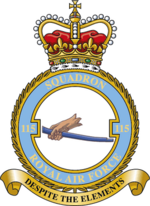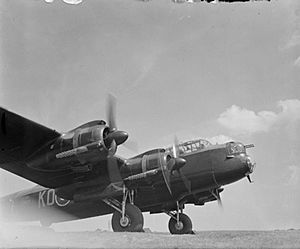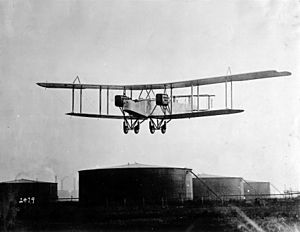No. 115 Squadron RAF facts for kids
Quick facts for kids No. 115 Squadron RAF |
|
|---|---|

Squadron badge
|
|
| Active | 1 December 1917 – 1 April 1918 (RFC) 1 April 1918 – 18 October 1919 (RAF) 15 June 1937 – 1 March 1950 13 June 1950 – 1 June 1957 21 August 1958 – 1 October 1993 1 October 2008 – present |
| Country | |
| Branch | |
| Type | Flying training squadron |
| Role | Qualified flying instructor training |
| Part of | No. 6 Flying Training School |
| Home station | RAF Wittering |
| Motto(s) | Despite the elements |
| Aircraft | Grob Tutor T1 |
| Battle honours |
|
| Insignia | |
| Squadron badge heraldry | A dexter hand erased at the wrist holding a tiller. The squadron laid great stress on the importance of navigation and the hand on the tiller is symbolic of this. Approved by King George VI in February 1938. |
| Squadron codes | BK (Apr 1939 – Sep 1939) KO (Sep 1939 – Mar 1950, Jun 1950 – Apr 1951) A4 Nov 1943 – Oct 1944 (only used by 'C' Flt) IL Nov 1944 – Aug 1945 |
No. 115 Squadron is a special unit of the Royal Air Force (RAF). It uses Grob Tutor T1 aircraft. Its main job is to train Qualified Flying Instructors (QFIs). These instructors then teach new pilots in other RAF squadrons and at University Air Squadrons. The squadron also checks and sets flying standards.
No. 115 Squadron first started during the First World War. Back then, it flew large Handley Page O/400 bomber planes. During World War II, it was a bomber squadron again. After that war, it continued as a bomber unit until 1958. Then, it changed roles to become a radio calibration unit. This meant it helped make sure radio signals for planes were accurate.
The squadron stopped being an active flying unit in 1993. However, it was brought back in 2008 at RAF Cranwell. It became No. 115(Reserve) Squadron, flying the Grob Tutor T.1. Later, it moved to its current home at RAF Wittering.
Contents
History of No. 115 Squadron
Early Days and First World War Missions
No. 115 Squadron was first formed on 1 December 1917. It started at RAF Catterick in Yorkshire. The squadron was part of the Royal Flying Corps (RFC) at that time.
In August 1918, the squadron received its Handley Page O/400 twin-engine bombers. It then joined the Independent Air Force in France. Their first bombing mission was on the night of 16/17 September. They dropped almost 4 tons of bombs on Metz-Sablon. The squadron was praised for this mission. It was called "the finest piece of work" by a new squadron.
One of their most successful missions was against Morhange airfield. Five O/400 planes made double trips. They dropped 6.5 tons of bombs on the target. During its time in France, No. 115 Squadron flew 15 bombing raids. They dropped a total of 26 tons of bombs. The longest raid was to Baden. The squadron returned to England in March 1919. It was officially stopped on 18 October 1919.
Reforming and New Aircraft
The squadron was started again on 15 June 1937. This happened at RAF Marham. It was now called No. 115 (Bomber) Squadron. For a short time, it flew the Fairey Hendon monoplane bomber. But these planes were soon replaced. The squadron then received the Handley Page Harrow. These planes were not very good for bombing. So, from March 1939, they were replaced with Wellington bombers.
No. 115 Squadron in World War II

During the Second World War, No. 115 Squadron flew many bombing missions. They also helped with "Gardening," which was the secret name for minelaying. This meant dropping naval mines into enemy waters.
In April 1940, while flying Wellingtons, they made history. They carried out the RAF's first bombing raid of the war on a mainland target. This target was the enemy-held Norwegian airfield of Stavanger Airport, Sola.
Sixteen months later, in August 1941, the squadron tested a new system. This was called Gee. It was the first of the big radar systems used for navigation and bombing. Because of their good report on these tests, Gee was made in large numbers. It became very important for RAF Bomber Command.
A pilot named Sydney Percival Smith wrote about his time with 115 Squadron. He flew Wellington missions in late 1942 from RAF East Wretham. These missions targeted cities in Germany like Bremen and Munich. They also laid mines in French ports and the Bay of Biscay.
In March 1943, the Wellingtons were replaced. The squadron started flying Hercules-engined Avro Lancaster B.IIs. Then, in March 1944, these were replaced by Merlin-engined Lancaster B.Is and B.IIIs. The squadron moved from RAF Little Snoring to RAF Witchford in November 1943.
After the War (1945–1957)
After World War II, No. 115 Squadron stayed active in the RAF. In September 1949, they received Avro Lincoln planes. The squadron was linked with No. 218 Squadron from February 1949 to March 1950. No. 115 Squadron was then stopped at RAF Mildenhall.
But it was reformed again on 13 June 1950. It became a Boeing Washington unit at RAF Marham. Again, it was linked with No. 218 Squadron. In February 1954, English Electric Canberra planes replaced the Washingtons. The squadron used Canberras until it was stopped again on 1 June 1957.
Calibration Role (1958–1993)
The squadron was brought back on 21 August 1958. This happened when No. 116 Squadron was renamed. It became a Radar Calibration unit. This means it helped make sure radar systems were working correctly. They flew Varsity and Valetta planes. For a short time, they also used Hastings planes.
In February 1968, Armstrong Whitworth Argosies started to arrive. By August 1970, the squadron only used Argosy planes. No. 115 Squadron moved to RAF Cottesmore in 1968. Then, in 1976, it moved to RAF Brize Norton.
Andover planes were added in November 1976. The last Argosy left in January 1978. In 1982, No. 115 Squadron moved to RAF Benson. The Andovers continued to be used until the squadron was stopped on 1 October 1993.
Flying Training Today (2008–Present)
The squadron was reformed once more on 1 October 2008. This was part of a big change in the RAF's basic flying training. No. 115(Reserve) Squadron was given a special job. It became the unit for the Central Flying School (Elementary). Its main task is to train new Qualified Flying Instructors (QFIs).
There are two main courses at the squadron. The 'Main Course' is for new instructors. It includes three weeks of classroom learning and 80 hours of flying. This course takes about six months. The 'Refresher Course' is for instructors who have taught before. It's also for those changing the type of aircraft they teach on. This course is two months long with 40 flying hours.
Most instructors who finish these courses will then work. They will teach at RAF Elementary Flying Training Squadrons. They also teach at University Air Squadrons. Some go to teach for the Army and Navy at RAF Barkston Heath.
Aircraft Operated by No. 115 Squadron
| From | To | Aircraft | Variant | Remark |
|---|---|---|---|---|
| Jul 1918 | Mar 1919 | Handley Page Type O | O/400 | |
| Jun 1937 | Aug 1937 | Fairey Hendon | Mk.II | (on loan from No. 38 Squadron RAF) |
| Jun 1937 | Sep 1939 | Handley Page Harrow | Mk.II | |
| Apr 1939 | Nov 1939 | Vickers Wellington | Mk.I | |
| Sep 1939 | Aug 1940 | Vickers Wellington | Mk.Ia | |
| Apr 1940 | Mar 1942 | Vickers Wellington | Mk.Ic | |
| Nov 1941 | Mar 1943 | Vickers Wellington | Mk.III | |
| Mar 1943 | May 1944 | Avro Lancaster | Mk.II | |
| Mar 1944 | Nov 1949 | Avro Lancaster | Mks.I, III | |
| Sep 1949 | Mar 1950 | Avro Lincoln | B.2 | |
| Aug 1950 | Feb 1954 | Boeing Washington | B.1 | |
| Feb 1954 | Jun 1957 | English Electric Canberra | B.2 | |
| Aug 1958 | Aug 1970 | Vickers Varsity | T.1 | |
| Oct 1963 | May 1964 | Vickers Valetta | C.1 | |
| Jan 1967 | Jan 1969 | Handley Page Hastings | C.2 | |
| Feb 1968 | Jan 1978 | Armstrong Whitworth Argosy | E.1 | |
| Nov 1976 | Oct 1993 | Hawker Siddeley Andover | C.1, E.3 | |
| Oct 2008 | present | Grob Tutor | T.1 |
Awards and Honours
Members of No. 115 Squadron have received many awards for their bravery and service. These include:
- 142 Distinguished Flying Cross (DFC) and 2 Bars (extra awards) to the DFC
- 68 Distinguished Flying Medal (DFM)
- 6 British Empire Medal (BEM)
- 4 Distinguished Service Order (DSO)
- 4 Member of the Order of the British Empire (MBE)
- 3 Air Force Cross (AFC)
- 2 Air Force Medal (AFM) and 1 Bar to the AFM
- 1 Conspicuous Gallantry Medal (CGM)
Images for kids





